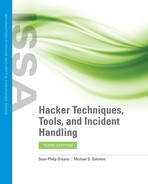Botnets and the Internet of Things (IoT)
An advanced type of attack mechanism is a botnet, which consists of computers and devices that are infected with software such as those used in DDoS attacks. When enough of these systems are infected to reach a critical mass, they can be used to do tremendous damage. Botnets can stretch from one side of the globe to another and be used to attack a system or carry out a number of other tasks.
In recent years, more and more devices, appliances, vehicles, and other objects of many types have included network communication hardware and software that allow them to connect to networks. These newly network capable devices are collectively known as the Internet of Things (IoT). Today, it isn’t uncommon for new vehicles, refrigerators, doorbells, home weather stations, and many other devices to be network capable. This means each of these devices contains a computer and network interface. Once connected to a network, and often the Internet, each of these devices becomes a possible DDoS attack source. Attackers know that most IoT devices have little or no security controls configured. Most of these devices are purchased by consumers with virtually no security training or awareness. As the IoT grows, so will the number of potential bots for future attacks.
Botnets can perform several attacks, including:
DDoS attacks—This construct makes sense as an attack method based on the way a DDoS works and the number of systems that can be infected.
Sending—Botnets have been used to transmit spam and other bogus information on behalf of their owner.
Stealing information—Attacks have also been carried out with botnets to steal information from unsuspecting users’ systems.
Click fraud—This attack is where the attackers infect a large number of systems with the idea that they will use the infected systems to click on ads on their behalf, generating revenue for themselves.
A “bot” is a type of malware that allows an attacker to take control of an affected computer or device. The term can also refer to the computer or device that is infected. Also known as “web robots,” bots are usually part of a network of infected devices known as a “botnet,” which is typically made up of victims’ computers and devices that stretch across the globe.
CHAPTER 11 ASSESSMENT
-
1. A DoS attack is meant to deny a service from legitimate usage.
A. True
B. False
-
2. Sniffers can be used to:
A. Decrypt information
B. Capture information
C. Hijack communications
D. Enforce security
-
3. Session hijacking is used to capture traffic.
A. True
B. False
-
4. Session hijacking is used to take over an authenticated session.
A. True
B. False
-
5. Active sniffing is used when switches are present.
A. True
B. False
-
6. ________ is used to overwhelm a service.
-
7. ________ is used to flood a switch with bogus MAC addresses.
-
8. ________ is used to fake a MAC address.
A. Spoofing
B. Flooding
C. Poisoning
D. Hijacking
-
9. What type of device can have its memory filled up when MAC flooding is used?
A. Hub
B. Switch
C. Router
D. Gateway
-
10. What technique is used when traffic is captured on a network with hubs?
A. Active sniffing
B. Passive sniffing
C. MAC flooding
D. Ether flooding
